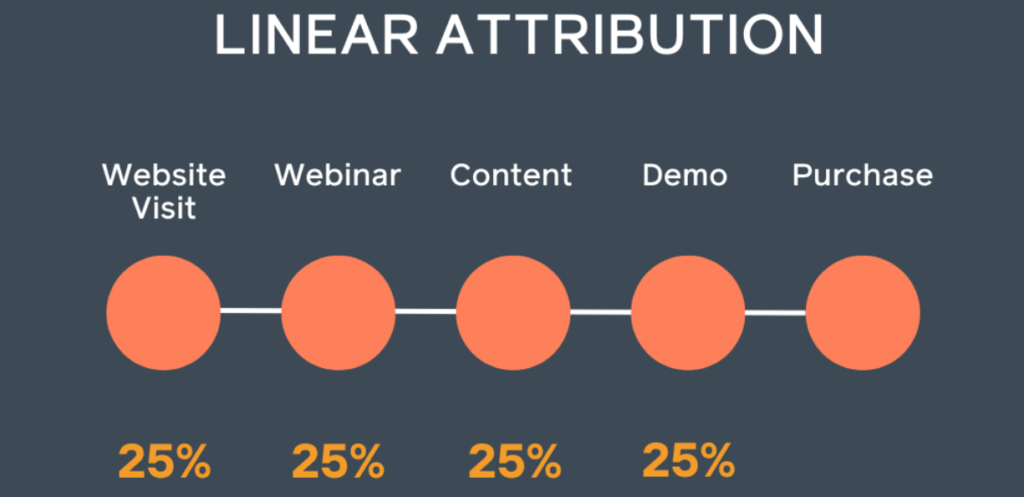In the world of advertising technology (AdTech), one of the most important challenges businesses face is measuring the effectiveness of their marketing efforts. With a multitude of channels and platforms used to reach potential customers, understanding how each touchpoint contributes to the final conversion (like a purchase or sign-up) is critical. One method used for this measurement is linear attribution. In this article, we’ll explore what linear attribution in adtech is, how it works, its pros and cons, and why it’s important in modern advertising strategies.
What is Linear Attribution in AdTech?
Linear attribution is a method of attributing equal credit to every touchpoint a customer interacts with on their path to conversion. In simple terms, if a customer interacts with multiple ads or channels before making a purchase, linear attribution gives each of those interactions equal weight.
For example, let’s say a consumer sees the following ads before buying a product:
- A social media ad.
- A Google search ad.
- An email campaign.
In linear attribution, all three touchpoints are credited equally for the conversion. If the product costs $30 and the company spent $90 on the three ads, each ad gets $30 worth of credit for the sale.
This approach is straightforward and easy to understand, making it a popular choice among marketers, especially those new to attribution models.
How Does Linear Attribution Work?
Linear attribution works by dividing the total credit for a conversion evenly across all touchpoints that a customer interacted with along their journey. Let’s break it down with a simple example:
Example:
Imagine a consumer interacts with the following sequence of touchpoints before completing a purchase:
- First touch: They click on a banner ad on a website.
- Second touch: They see a retargeting ad on Facebook.
- Third touch: They receive an email offer and click through to the website to make the purchase.
With linear attribution, the marketer would give equal credit to each of these touchpoints, regardless of how close they were to the actual conversion. In this case, the total credit for the conversion (e.g., $100) would be split evenly among the three touchpoints, meaning each would receive $33.33 worth of credit.
The formula for linear attribution is simple:
Credit per touchpoint = Total Conversion Value/Number of Touchpoints
In this case:
Credit per touchpoint = 100/3 = 33.33
This is how linear attribution distributes credit to all touchpoints evenly, providing an equal share of the conversion value to each interaction.
Pros of Linear Attribution in AdTech
1. Simplicity and Ease of Use
Linear attribution is easy to understand and implement. For businesses that are just starting with attribution modeling or those who don’t have complex data systems in place, this method offers a simple approach to measuring marketing efforts.
2. Fair Distribution of Credit
By allocating equal credit to each touchpoint, linear attribution ensures that all marketing efforts, regardless of when they happen in the customer journey, are recognized. This can be especially useful for businesses using multi-channel strategies who want to avoid leaving out any part of their campaign.
3. Good for High-Volume Campaigns
For businesses with high volumes of customer interactions, linear attribution helps provide a broader picture of how each ad or campaign contributes to the customer journey. This can be beneficial for companies trying to understand the overall effectiveness of their marketing efforts.
Cons of Linear Attribution
1. Ignores the Value of Last Touch
One significant limitation of linear attribution is that it doesn’t account for the fact that some touchpoints may have had a bigger impact on the final decision. For instance, a customer may have been introduced to a brand through a display ad but ultimately decided to purchase after receiving a final push from a highly targeted email. Linear attribution treats both interactions equally, even though the email may have been the deciding factor.
2. Doesn’t Consider Time or Frequency
Linear attribution also fails to consider the timing and frequency of touchpoints. For example, a person may have seen a banner ad multiple times over the course of weeks, but this would be treated the same as a one-time interaction with a search ad. This approach doesn’t fully account for how repeated exposure might influence a customer’s decision.
3. Over-Simplification
While simplicity can be a strength, linear attribution’s equal distribution of credit across all touchpoints can also be a weakness. Many customer journeys are complex, and some channels might be more influential than others. Linear attribution doesn’t capture these nuanced differences.
When to Use Linear Attribution
Despite its drawbacks, linear attribution can be useful in certain situations:
- Early-Stage Campaigns: If a company is new to attribution modeling or has simple campaigns, linear attribution can provide a quick, straightforward view of performance.
- Brand Awareness Campaigns: For campaigns focused on broad awareness rather than conversions, linear attribution can ensure that all touchpoints receive recognition for their role in increasing visibility.
- Simple or Multi-Channel Campaigns: If a company is running ads across various channels without a clear understanding of which one is most important, linear attribution can offer an impartial way of measuring each channel’s contribution.
Alternatives to Linear Attribution in AdTech
While linear attribution is popular for its simplicity, other models might offer more accurate insights into the effectiveness of your marketing strategy. These include:
- Last-Click Attribution: All credit goes to the last touchpoint before the conversion.
- First-Click Attribution: All credit is given to the first touchpoint.
- Time Decay Attribution: More credit is given to touchpoints closer to the conversion.
Each of these models has its advantages and can be chosen based on the specific needs of the campaign or business.
Conclusion

Linear attribution is a simple and easy-to-understand model for allocating credit across multiple marketing touchpoints. It treats each interaction as equally important. This makes it a useful tool for businesses just starting to measure their ad performance. The model provides a clear and straightforward approach to understanding customer interactions. However, its equal distribution of credit can overlook the nuances of customer behavior. For example, it doesn’t account for which touchpoints might have a more significant impact on conversion. As your business matures, the complexities of your marketing efforts may require a more nuanced approach. Therefore, it’s important to consider other attribution models as your marketing strategies evolve.
By understanding the strengths and weaknesses of linear attribution, businesses can make more informed decisions about their advertising strategies. This understanding helps improve their ability to track and optimize their marketing spend. It ultimately leads to more effective and efficient marketing efforts.
Frequently Asked Questions (FAQs)
1. What is Linear Attribution in AdTech?
Linear attribution is a method of distributing equal credit to all touchpoints a customer interacts with before making a conversion, such as a purchase. Each interaction, whether it’s an ad click, an email, or a website visit, is given the same weight. This approach ensures that every touchpoint plays a role in the conversion process.
2. How Does Linear Attribution Work?
Linear attribution divides the total credit for a conversion evenly across all the touchpoints a customer encounters. For example, if a customer interacts with three ads before buying a product, each ad would receive equal credit for the final sale.
3. What Are the Advantages of Using Linear Attribution?
The main benefits of linear attribution are its simplicity, ease of implementation, and fairness. It ensures that every marketing touchpoint gets credit. This makes it ideal for businesses running multi-channel campaigns. It is also a good choice for those looking for a straightforward measurement approach.
4. What Are the Limitations of Linear Attribution?
Linear attribution doesn’t account for the varying influence of different touchpoints. It assumes all interactions have an equal impact, which may not be accurate. This approach also overlooks factors such as the timing and frequency of customer interactions. This can play a significant role in the decision-making process.


